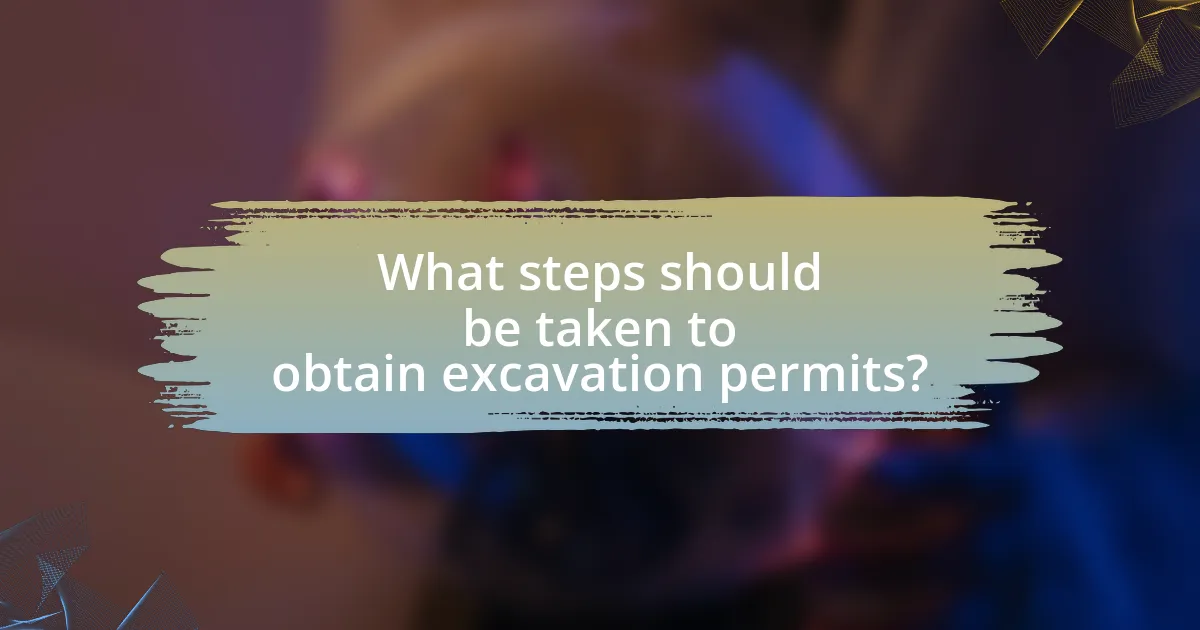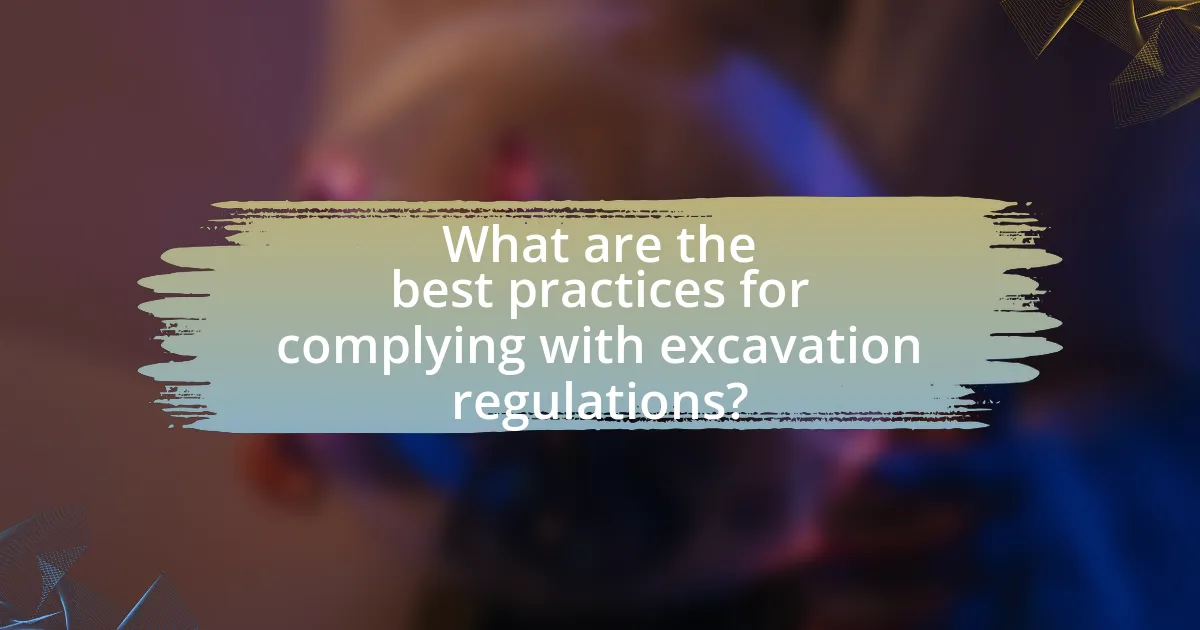The article focuses on the essential permits and regulations required for fossil excavation, emphasizing the importance of compliance with federal, state, and local laws. Key regulations include the Paleontological Resources Preservation Act, which mandates permits for excavating fossils on federal lands, and various state laws that govern fossil collection. The article outlines the types of permits needed, the application process, and the potential legal and environmental risks associated with unauthorized excavation. Additionally, it discusses best practices for ensuring compliance and the consequences of non-compliance, highlighting the significance of environmental assessments and staying informed about regulatory changes.

What are the essential permits and regulations for fossil excavation?
Essential permits for fossil excavation include federal, state, and local permits, which vary by jurisdiction. In the United States, the primary federal regulation is the Paleontological Resources Preservation Act, which requires permits for excavating fossils on federal lands. Additionally, state laws often mandate permits for fossil collection, especially in protected areas or state parks. Local regulations may also apply, particularly concerning land use and environmental impact. Compliance with these regulations ensures legal excavation and conservation of fossil resources.
Why are permits necessary for fossil excavation?
Permits are necessary for fossil excavation to ensure legal compliance and protect scientific and cultural resources. Fossil excavation often occurs on public lands or sites of significant geological or archaeological importance, where regulations are in place to manage and preserve these resources. For instance, the Paleontological Resources Preservation Act in the United States mandates permits for fossil collection on federal lands to prevent unauthorized removal and ensure that excavations are conducted responsibly and scientifically. This legal framework helps safeguard fossils from damage and promotes ethical research practices.
What risks are associated with fossil excavation without permits?
Fossil excavation without permits poses significant legal and environmental risks. Engaging in unauthorized excavation can lead to legal penalties, including fines and potential imprisonment, as many jurisdictions have strict laws protecting fossil sites. Additionally, unregulated excavation can result in the destruction of valuable scientific information and damage to ecosystems, as excavators may not follow best practices for site preservation. Historical cases, such as the 2015 incident in the United States where individuals faced criminal charges for illegally excavating fossils, illustrate the serious consequences of such actions.
How do permits protect fossil sites and scientific integrity?
Permits protect fossil sites and scientific integrity by regulating excavation activities and ensuring that fossil resources are preserved for research and education. These permits require adherence to specific guidelines that minimize damage to fossil sites, thereby maintaining their scientific value. For instance, the National Park Service mandates permits for fossil collection in national parks, which helps prevent unauthorized digging and ensures that fossils are collected in a scientifically responsible manner. This regulatory framework not only safeguards the physical integrity of fossil sites but also promotes ethical research practices, ensuring that findings contribute to the broader scientific community.
What types of permits are required for fossil excavation?
Fossil excavation typically requires several types of permits, including scientific research permits, land use permits, and sometimes specific excavation permits depending on the jurisdiction. Scientific research permits are often issued by governmental or academic institutions to ensure that excavations are conducted for educational or research purposes. Land use permits are necessary to authorize the use of specific land for excavation activities, which may involve private, state, or federal land. Additionally, some regions may require specific excavation permits that outline the methods and practices to be used during the fossil excavation process. These permits are essential to comply with local, state, and federal regulations aimed at protecting paleontological resources.
What is a scientific research permit?
A scientific research permit is an official authorization required to conduct research activities, particularly in sensitive or regulated environments. This permit ensures that research complies with legal, ethical, and environmental standards, protecting both the integrity of the research and the ecosystems involved. For example, in the context of fossil excavation, obtaining a scientific research permit may involve demonstrating the significance of the research, outlining methodologies, and ensuring minimal impact on the site. Such permits are often issued by governmental or regulatory bodies, which assess applications based on established criteria to safeguard natural and cultural resources.
What is a commercial excavation permit?
A commercial excavation permit is a legal authorization required for businesses to conduct excavation activities, typically involving the removal of soil, rock, or other materials from a site. This permit ensures that the excavation complies with local regulations, environmental standards, and safety protocols. For instance, many jurisdictions mandate that commercial excavation permits be obtained to protect public safety and preserve natural resources, as outlined in local zoning laws and environmental protection regulations.
How do regulations vary by location for fossil excavation?
Regulations for fossil excavation vary significantly by location, influenced by local, state, and federal laws. For instance, in the United States, fossil excavation on federal lands is governed by the Paleontological Resources Preservation Act, which requires permits and adherence to specific guidelines, while state lands may have their own regulations, such as California’s stringent laws protecting fossils. Additionally, countries like Canada and Australia have distinct frameworks; Canada mandates permits for fossil collection under provincial laws, and Australia has varying regulations depending on the state, often requiring permits for excavation in protected areas. These differences reflect the local governance structures and conservation priorities, underscoring the importance of understanding specific regulations in each jurisdiction before conducting fossil excavation.
What federal regulations govern fossil excavation in the United States?
The federal regulations governing fossil excavation in the United States primarily include the Paleontological Resources Preservation Act (PRPA) of 2009, which protects fossils on federal lands and requires permits for excavation. Additionally, the National Environmental Policy Act (NEPA) mandates environmental assessments for projects that may impact fossil resources. The Bureau of Land Management (BLM) and the U.S. Forest Service enforce these regulations, ensuring that fossil excavation is conducted responsibly and sustainably.
How do state regulations differ from federal regulations?
State regulations differ from federal regulations primarily in their scope and authority, with state regulations governing specific local issues while federal regulations apply nationwide. For example, fossil excavation permits may vary significantly between states, as each state has its own laws regarding the protection of paleontological resources, which can include specific requirements for excavation methods, reporting, and conservation practices. In contrast, federal regulations, such as those enforced by the Bureau of Land Management, establish overarching guidelines that apply to federal lands and may include broader protections for fossils across multiple states. This distinction is crucial for fossil excavation, as compliance with both state and federal regulations is necessary to ensure legal and responsible practices.

What steps should be taken to obtain excavation permits?
To obtain excavation permits, one must follow a series of specific steps. First, identify the regulatory authority responsible for issuing excavation permits in the relevant jurisdiction, which may vary by state or local government. Next, prepare a detailed excavation plan that outlines the scope of the project, including the location, methods, and duration of the excavation. This plan should also address environmental considerations and potential impacts on the surrounding area.
After preparing the plan, submit the application for the excavation permit along with any required documentation, such as site maps, environmental assessments, and proof of insurance. It is essential to pay any associated fees at this stage. Following submission, the regulatory authority will review the application, which may involve public notifications or hearings, depending on local regulations.
Once the review process is complete, the authority will either approve or deny the permit. If approved, the permit will outline specific conditions that must be adhered to during the excavation process. Compliance with these conditions is crucial to avoid penalties or revocation of the permit.
How can one apply for a fossil excavation permit?
To apply for a fossil excavation permit, an individual must submit a formal application to the relevant governmental authority, typically a state or federal agency responsible for natural resources or cultural heritage. This application usually requires detailed information about the proposed excavation site, the purpose of the excavation, and the methods to be used. Additionally, applicants may need to provide evidence of qualifications or experience in paleontology or geology.
In the United States, for example, the Bureau of Land Management (BLM) and the U.S. Forest Service oversee fossil excavation permits on public lands, and their guidelines specify the necessary documentation and fees involved in the application process.
What documentation is typically required for the application?
The documentation typically required for the application for fossil excavation permits includes a detailed project proposal, a site plan, and proof of land ownership or permission from landowners. The project proposal outlines the objectives, methods, and duration of the excavation, while the site plan provides a visual representation of the excavation area. Proof of land ownership or permission is necessary to ensure legal access to the excavation site. These requirements are established by regulatory bodies to ensure compliance with environmental and archaeological standards.
How long does the permit application process usually take?
The permit application process for fossil excavation typically takes between three to six months. This duration can vary based on factors such as the complexity of the project, the specific regulations of the jurisdiction, and the completeness of the application submitted. For instance, in the United States, the Bureau of Land Management states that processing times can be influenced by the need for environmental assessments or public consultations, which may extend the timeline.
What are the common challenges faced during the permit application process?
The common challenges faced during the permit application process include lengthy approval timelines, complex regulatory requirements, and insufficient guidance from authorities. Lengthy approval timelines can delay projects significantly, as some permits may take months or even years to process. Complex regulatory requirements often involve navigating multiple jurisdictions and understanding various legal stipulations, which can be overwhelming for applicants. Additionally, insufficient guidance from authorities can lead to confusion and misinterpretation of the application process, resulting in incomplete submissions and further delays. These challenges are frequently reported in studies on regulatory processes, highlighting the need for streamlined procedures and clearer communication from permitting agencies.
What issues can arise from incomplete applications?
Incomplete applications can lead to significant delays in the permit approval process for fossil excavation. When essential information is missing, regulatory bodies may reject the application or request additional documentation, prolonging the timeline for obtaining necessary permits. This can result in lost opportunities for excavation during optimal seasons, increased costs due to extended project timelines, and potential legal complications if excavation occurs without proper authorization. Furthermore, incomplete applications may hinder the ability to assess environmental impacts accurately, which is crucial for compliance with regulations.
How can applicants address potential objections from regulatory bodies?
Applicants can address potential objections from regulatory bodies by conducting thorough research and preparing comprehensive documentation that demonstrates compliance with all relevant regulations. This includes providing detailed environmental impact assessments, ensuring adherence to safety standards, and engaging with stakeholders to address concerns proactively. For instance, the National Environmental Policy Act (NEPA) requires federal agencies to assess the environmental effects of their proposed actions before making decisions, which underscores the importance of detailed assessments in mitigating objections. By presenting clear, factual evidence and maintaining open communication with regulatory bodies, applicants can effectively reduce the likelihood of objections and facilitate smoother approval processes.

What are the best practices for complying with excavation regulations?
The best practices for complying with excavation regulations include obtaining necessary permits, conducting thorough site assessments, and adhering to safety protocols. Obtaining permits ensures that the excavation complies with local, state, and federal laws, which often require specific documentation and approval before work begins. Conducting site assessments helps identify potential hazards, such as underground utilities or protected species, which must be addressed to avoid legal repercussions. Adhering to safety protocols, including proper training for workers and the use of appropriate equipment, minimizes risks and aligns with Occupational Safety and Health Administration (OSHA) standards. These practices collectively ensure compliance with regulations and promote safe excavation operations.
How can excavators ensure compliance with local regulations?
Excavators can ensure compliance with local regulations by thoroughly researching and understanding the specific laws and guidelines governing excavation activities in their area. This includes obtaining necessary permits, adhering to safety standards, and following environmental regulations. For instance, many regions require excavators to submit detailed plans that outline the excavation process, which must be approved by local authorities before work begins. Additionally, excavators should regularly consult with legal experts or local regulatory bodies to stay updated on any changes in legislation. Compliance can also be reinforced by maintaining accurate records of all permits and inspections, which serve as proof of adherence to local regulations.
What role do environmental assessments play in compliance?
Environmental assessments are critical for ensuring compliance with environmental regulations during fossil excavation. They evaluate potential environmental impacts of proposed projects, helping to identify risks and necessary mitigation measures. By conducting these assessments, companies can demonstrate adherence to legal requirements, such as the National Environmental Policy Act in the United States, which mandates environmental reviews for federal actions. This process not only aids in obtaining necessary permits but also minimizes the likelihood of legal challenges and fines associated with non-compliance.
How can excavators stay updated on changing regulations?
Excavators can stay updated on changing regulations by regularly consulting official government websites and industry associations that publish updates on legal requirements. These sources provide timely information on new laws, amendments, and compliance guidelines relevant to excavation activities. For instance, the Occupational Safety and Health Administration (OSHA) and the Environmental Protection Agency (EPA) frequently update their regulations, which can directly impact excavation practices. Additionally, attending industry conferences and workshops can facilitate networking with regulatory experts and peers, further enhancing awareness of regulatory changes.
What are the consequences of non-compliance with excavation regulations?
Non-compliance with excavation regulations can lead to significant legal and financial consequences. Violators may face fines that can range from hundreds to thousands of dollars, depending on the severity of the violation and local laws. Additionally, non-compliance can result in the suspension or revocation of excavation permits, which halts any ongoing or future excavation activities. Furthermore, legal action may be initiated by regulatory bodies, leading to potential criminal charges in severe cases, especially if the violation results in environmental damage or harm to protected sites. These consequences underscore the importance of adhering to established excavation regulations to avoid detrimental outcomes.
What legal penalties can result from unauthorized excavation?
Unauthorized excavation can result in legal penalties such as fines, imprisonment, and the forfeiture of equipment. For instance, in the United States, the Archaeological Resources Protection Act imposes fines up to $100,000 and imprisonment for up to five years for unauthorized excavation of archaeological sites on federal land. Additionally, state laws may impose further penalties, including civil fines and restitution for damages caused to the site. These penalties are enforced to protect cultural heritage and ensure compliance with excavation regulations.
How can non-compliance affect future excavation opportunities?
Non-compliance with excavation regulations can severely limit future excavation opportunities by resulting in legal penalties, loss of permits, and damage to professional reputation. When excavation projects do not adhere to established guidelines, regulatory bodies may impose fines or revoke necessary permits, making it difficult for individuals or organizations to conduct future excavations. For instance, a study by the National Park Service indicates that non-compliance can lead to a 50% increase in the time required to obtain new permits, as applicants must demonstrate compliance history before being considered for approval. Additionally, a tarnished reputation can deter potential collaborators and funding sources, further restricting access to excavation sites.
What practical tips can help in navigating permits and regulations for fossil excavation?
To navigate permits and regulations for fossil excavation effectively, researchers should first thoroughly research local, state, and federal laws governing fossil collection. Understanding the specific requirements, such as obtaining permits from relevant authorities like the Bureau of Land Management or state geological surveys, is crucial. For instance, in the United States, the Paleontological Resources Preservation Act mandates permits for fossil excavation on federal lands, highlighting the importance of compliance with legal frameworks. Additionally, engaging with local fossil clubs or professional organizations can provide valuable insights and guidance on best practices and regulatory updates.





